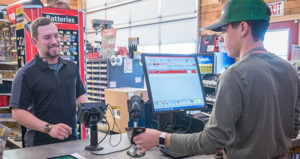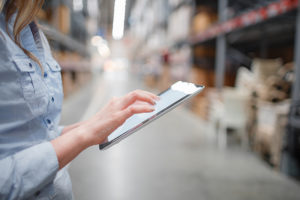Retail Technology Helps You do More with Less
Ever since the invention of the cash register, retail technology has been making it easier for merchants to do business. Cash registers simplified the calculation of items sold and streamlined customer checkout. Point of sale systems computerized check out, inventory and ordering. Today, retail technology simplifies more than final sales.
Retail technology, also known as point-of-sale systems or retail management platforms, is more important than ever. The pandemic and its economic fallout have created a labor shortage and has heightened the need for streamlining processes.
56% of U.S. small business owners reported hiring or trying to hire in February 2021.
40% of them reported job openings that could not be filled.
24% listed labor quality as their top business concern, according to the National Federation of Independent Business.
 Efficient Checkout Means Happy Customers, Employees
Efficient Checkout Means Happy Customers, Employees
One of the first tasks retail technology solved was increasing the speed and accuracy of how merchants process customer sales. Improving the checkout process is key to customer satisfaction and being able to run a store with fewer available checkers.
“A system with a user-friendly interface makes it easy for anyone, even those apprehensive about using a computer, to become productive after minimal training,” says Dan Nesmith, founder and president of Paladin Data Corporation, a leading provider of retail technology solutions.
There’s an old business axiom that within the first six months of work, approximately one-third of a store’s new hires will quit. Hiring and training new staff costs both time and money.
A point-of-sale system (POS) that is easy to learn, teach and use is essential. They also make it easier and more enjoyable for employees to do their jobs.
“We appreciate the flexibility of this system and the difference it has made for our customers as well as our employees,” says Wanda McCullers, who, along with husband Clint, owns and operates Farmers Feed Service in Wetumpka, Alabama. “Some of our employees were terrified of computers. Once we got this system, some of them got home computers and internet service. So, this has been a great opportunity for growth for our company and our employees, as well.”
Inventory, Ordering is a Retail Automation Specialty
Comprehensive retail technology streamlines tasks like inventory and restocking so much that many stores can perform them with less effort and fewer people. Tools such as RF guns and barcode scanners make the manual processes a breeze. The accompanying software is designed to make ordering just as easy.
In-store technology plays a significant role in reducing out-of-stock items, increasing sales, generating a larger gross profit, and shrinking the amount of money invested in inventory, Nesmith explains.
“The best tools equate to the best results. Stores need to allow technology’s use of sophisticated forecasting models to automatically tailor their inventory to meet customers’ expectations,” he says.
Optimize Your POS
One of the biggest labor-saving moves any retail business can make is to use its retail management system to its fullest. A good system has many components and offers many functions. They feature:
An intuitive, easy-to-use point of sale system.
An extensive inventory management program that can suggest orders, search for the lowest prices and split purchase orders to reflect those separate purchases, and automatically send those orders to suppliers through electronic data interchange (EDI). Some can also alert stores about stock on hand in their suppliers’ distribution centers.
Ways to track and set margins.
Reports or visual displays on how a business is performing.
Specialty calculators that help with product sales.
Workforce management tools.
Integrations with bookkeeping and accounting programs.
“When incorporating a retail platform into a business, it’s paramount you fine-tune your store processes into the technology, not the other way around,” says Charles Owen, chief experience officer for Paladin Data Corporation. “Too many businesses purchase a retail system envisioning the way it will fit into their current workflows or processes. That’s wrong. Retail technology works best when it’s used the way it was designed. This means putting your trust, faith, effort and investment into learning how to properly use the equipment and software.”
Using a system the way it was designed to be used might seem difficult for some retailers, but the results speak for themselves.
“I’m an old codger – not very tech-minded – and, of course, I resisted change. I wanted to keep doing business in the shoebox,” says Dennis Gamble, owner of Tri-County Hardware and Farm Supply in Paxton, Florida, who uses a Paladin system to run his business. “This is the first system we’ve had and it works real well for us.
“This has been a labor-saver for me. The way the accountant wanted our paperwork, it was labor-intensive to put together. We put in sales, cash, credit, checks and accounts received by hand, and that better tally up to how much business we have done that day. Now, it’s all done at the front desk. It cut a lot of hours out of my week.”
 Using all Your Tools
Using all Your Tools
Optimizing your retail technology means more than using computer terminals and software to streamline inventory, ordering, and customer checkout. Mobile devices that are linked to your retail management system can improve customer service.
Mobile POS devices, RF guns, tablets, and smartphones empower sales associates to look up products for customers, make deliveries, or complete sales without having to be at the checkout stand.
Any business that’s not optimizing the use of its most valuable and comprehensive tool is not taking advantage of its most valuable and versatile asset.
brian bullock
Author


